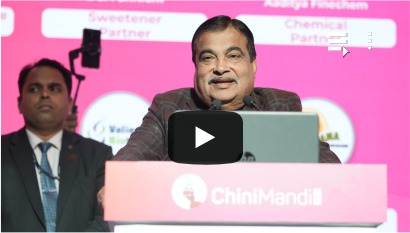The Ethanol Blended Petrol (EBP) programme has been one of the biggest success stories in India’s quest to achieve sustainability. Over the past few years, blending of ethanol increased from 12.06% in ESY 2022-23 to 19.7 per cent in April 2025, showing the right policy framework by the Government and a remarkable support from the sugar and ethanol industry. India’s ethanol drive has so far added Rs 1,07,580 crore to farmers’ earnings while saving Rs 1,26,210 crore in foreign exchange by curbing crude oil imports.
With India achieving the E20 target ahead of target, the conversation has now shifted towards achieving a potential 30% target by 2030. Achieving this vision will require scalable infrastructure, flexible feedstock usage, and consistent policy frameworks that support sustainable pricing and growth across the value chain.
To transition beyond the 20% ethanol blending milestone, India must adopt a forward-looking roadmap centred on advanced biofuel technologies and integrated systems thinking. A key pillar of this vision is the large-scale deployment of Second-Generation (2G) ethanol technologies that convert agricultural residues into fuel, thus avoiding food-versus-fuel conflicts while enhancing environmental sustainability and food security.
Simultaneously, a faster rollout of Flex-Fuel Vehicles (FFVs) and Hybrid Electric Vehicles (HEVs) capable of operating on higher ethanol blends is critical. These vehicles serve as an important bridge between conventional fossil fuel systems and a low-carbon future, offering cleaner, more flexible mobility options.
Creating ethanol-integrated bio-hubs in sugarcane-rich regions is another enabler. These hubs, combining ethanol production with co-generation of bioelectricity, biogas, and biofertilizers, represent a model for resource-efficient, circular rural economies.
Sugar Industry at the Heart of Ethanol Growth
The Indian sugar industry continues to be the foundation of the ethanol economy. Companies like Triveni Engineering & Industries Ltd (TEIL) have emerged as key contributors to India’s ethanol production ambitions. TEIL’s investments in dual-feed distilleries and cutting-edge ethanol technologies have significantly bolstered national blending targets.
TEIL operates advanced distillation facilities across Uttar Pradesh. It has state-of-the-art distilleries spread across Muzaffarnagar (MZN) – 2 facilities, Sabitgarh (SBT), Milak Narayanpur (MNP), Rani Nangal (RNG) and Shamli in Uttar Pradesh. These facilities have the capability to produce Ethanol, Extra Neutral Alcohol (ENA), Rectified Spirit (RS) and Denatured Spirit (SDS). TEIL utilises a mix of sugarcane-based feedstocks as well as grain. Distillers Dried Grain Solubles (DDGS), a co-product produced on grain operations is also sold to premium Institutions and it also manufactures Indian Made Indian Liquor (IMIL) and Indian Made Foreign Liquor (IMFL).
TEIL has also increased its sugarcane crushing capacity from 61,000 TCD to 63,000 TCD for Sugar Season 2024–25, further supporting upstream integration.
Overcoming Bottlenecks
Scaling beyond E20 will require resolving structural challenges—chief among them, feedstock diversification. Continued dependence on sugarcane and surplus FCI rice is unsustainable. India must aggressively promote maize and other non-food biomass to ensure supply chain resilience. Companies like TEIL, with feedstock-diverse distillation infrastructure, play a vital role in this transition, but long-term viability depends on pricing models that reflect input cost realities.
Policy measures will also be pivotal—rationalising GST for FFVs (5%), introducing differential pricing for ethanol fuels, and achieving Total Cost of Ownership (TCO) parity with electric vehicles can unlock consumer adoption. A pricing mechanism linked to the Fair and Remunerative Price (FRP) of sugarcane can provide the predictability needed for sustained producer investments.
Further, India must invest in innovation—spanning ethanol-to-hydrogen pathways, Sustainable Aviation Fuel (SAF) production, and carbon capture—to expand ethanol’s utility beyond blending and into broader clean energy use cases.
Balancing Global Pressures with Domestic Priorities
As blending levels rise, international trade dynamics are growing more complex. The United States is seeking greater access to the Indian ethanol market, particularly for fuel-grade imports. However, large-scale imports contradict the foundational goals of India’s Ethanol Blended Petrol (EBP) Programme—namely, strengthening domestic agriculture and reducing foreign exchange outflows.
India’s ethanol policy must align with Atmanirbhar Bharat, emphasising self-reliance while selectively embracing global collaboration in R&D, innovation, and technology transfer.
A Transformative Opportunity
Ultimately, the road beyond E20 is not just a matter of volume but of vision. Ethanol sits at the confluence of India’s energy, agricultural, and climate goals. With forward-looking policy, industry commitment, and technology adoption, ethanol can evolve into a multi-dimensional, low-carbon energy platform. For leaders like TEIL, sustaining this momentum requires a stable policy environment, feedstock viability, and long-term pricing mechanisms that support continued innovation and capacity growth.
The next phase of India’s ethanol journey must be bold, inclusive, and transformative – anchored in sustainability, resilience, and national self-reliance.

















